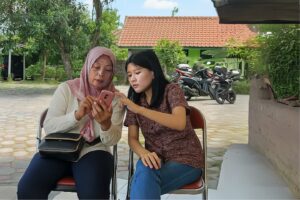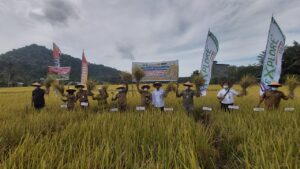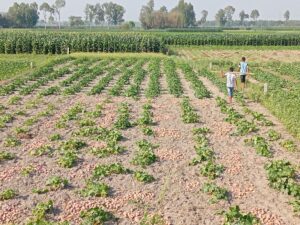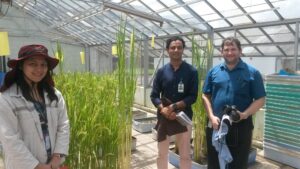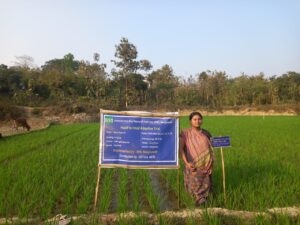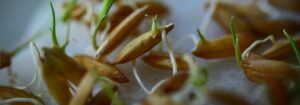Japan has long defended and quite successfully managed to maintain sovereignty in its international agricultural trade policies and agreements. Through various threats of sanctions, the high tariffs on foreign rice have kept Japanese farmers self-sustaining. Though self-sufficiency in decline since World War II, the rice industry (except for the rice crisis) has remained at 100%.
However, the effects of the 11 March multifaceted disaster (also known as the Japan 3.11 disaster), which hit the eastern region of Japan, have wreaked havoc on the long- and short term prospects of the rice industry. The usual 1.84 million-ton rice stockpile (as of October 2010) increased to 2.1 million tons because of the sluggish demand for rice in 2011, according to the Ministry of Agriculture, Forestry, and Fisheries.
Products from Fukushima considered safe
On 22 April 2011, Fukushima Governor Yuhei Sato was quoted saying that he would never allow Tokyo Electric Power Co. to operate the Daichi nuclear power plant again. On 11 September, in a message to Japan, Governor Sato said, “All the agricultural, forestry, and fishery products are under strict screening and products over the restriction values are prohibited from being distributed in the market; therefore, I can assure that you can buy and eat any products in the market.”
And, a document dated 12 October 2011 by Governor Sato on the official Fukushima Prefecture Web site stated: “The agricultural products provided by Fukushima Prefecture are safe and fresh. I hope everyone will give Fukushima Prefecture full support for our agricultural products.”
This statement was followed by a long list of categorized cereal grains (including rice) and vegetable products produced in Fukushima. These products passed the test for consumption and shipment, yet with numerous exceptions listed below each category.
A representative from the prefecture office explained through a phone call that the agricultural products listed had passed inspection for contamination, and mentioned a list of areas from which agricultural products are not allowed to be shipped for consumption. These areas were near the no-entry zone of Fukushima. Other areas were slightly farther away from the no-entry zone, but were labeled as hotspots because of consistent weather patterns, which carry contamination by wind and precipitation. Hence, the prefectural government is stating that, since agricultural product samples (including rice) have been inspected and have passed the 500-Becquerel test, all products shipped from Fukushima are considered safe for human consumption. A Becquerel (Bq) is a unit that is used to measure the rate of nucleus decay per second in radioactive material. In other words, 1 Bq indicates that 1 nucleus is decaying per second. Hence, a more dangerous source will produce a higher Becquerel reading.
Status of Fukushima’s rice industry
In a phone interview, Jessica Harvey, a member of the prefectural government office, indicated that since the prefecture was already in financial difficulty before the 3.11 disaster, the state is in no position to offer any assistance to any farmers, rice farmers included. The sale of agricultural products, including rice and sake (rice wine), had been a significant source of financial income for the prefecture until now. With the devastation of consumer trust in the products, the representative said that the local rice industry has been virtually destroyed.
The disaster affected three kinds of farmers: those in the 30-km no-entry zone (see map, click to enlarge), those who were dislocated because of the earthquake, and those far-removed from the situation but affected by the radiation concerns, said Mr. Fuji, a representative of the National Federation of Agricultural Cooperative Associations under its rice and wheat division. Keeping that in mind, in a public statement made on 29 October, Minister of Environment Goshi Hosono indicated that the no-entry zone was to be shrunk to a 20-km area in the near future.
With respect to the actual damage inflicted on Japan’s rice industry as a whole, Mr. Fuji put it as a minuscule 1%. With the earthquake, tsunami, and radiation factors, only 100,000 tons of rice were lost in all of the affected prefectures. He said that, of the 23,000 hectares of agricultural land affected, 20,000 hectares were rice production areas.
Mr. Fuji went on to describe the 500-Becquerel limit imposed by the Japanese government and how the agricultural community went on to carry out this safety policy. He indicated that, in all the test samples taken of unpolished genmai rice (the most likely to test positive for radiation because the outer bran layer has not been removed), no figures rose above the 500-Bq limit. However, he went on to say that tested samples that have higher values, such as 480 Bq, would not appear on supermarket shelves. Instead, the local agricultural associations (such as Japan Agriculture) would buy the rice themselves so that farmers would not lose profits. What was then done with the slightly tainted rice was not further explained. Since this interview, a few cases of contaminated rice found in supermarkets have been reported and Fukushima Prefecture was not allowed to sell any rice as of early December. Mr. Fuji stated that this protocol (and other information discussed by him) is outlined in detail on the Ministry of Agriculture, Forestry, and Fisheries Web site.
A problem of salt
The most immediate effort by the rice industry, in cooperation with the governments of various levels, is the removal of salt from brine-damaged rice paddies affected by the tsunami. Mr. Fuji said, with no hesitation, that the government is supporting the farmers on a financial and advisory level in this area.
The Ministry of Agriculture, Forestry, and Fisheries has projected that clean-up of agricultural land, reconstruction of paddies, and removal of rubble, debris, and brine will be completed by 2014. The radiation problem, on the other hand, was not an easy question to answer. After a slight pause, he said that nothing has been decided by the government on this issue.
“First of all, the no-entry zone of 30 km poses its own problems, but the topsoil of the surrounding areas is a long-term issue, which no one seems to be addressing yet,” he said.
In an interview with Philippe Nibelle of Aizu University, a 9-year resident of Aizu Wakamatsu in Fukushima Prefecture, he indicated that since the 30- km zone has been recently reduced to 20 km, some farmers have returned to their properties. However, they do not have the finances to remove the top layer of contaminated soil from their fields in order to put in a crop for next year. He said they are not receiving any financial support from the government (either federal or prefectural). Hence, the farmers have not benefited from the reduction of the 30-km no-entry zone. One “topsoil” issue, which seems to have been immediately dealt with, is that of local elementary, junior high, and high schools. These schools have removed the top few centimeters of soil from playgrounds.
Mr. Fuji further said that concerns about the future capacity for a steady rice supply were paled by the greater concern related to consumer confidence in future Tohoku rice products. Beyond the 30-km no-entry zone, successful rice growth because of effective brine removal in tsunami areas (spring 2011) also points to a productive 2012.
___________________
Ms. Jennifer Toews-Shimizu joined as consultant, Communication and Publications Services


